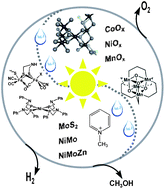Recent advances in hybrid photocatalysts for solar fuel production
Abstract
Converting solar energy into

* Corresponding authors
a
Energy Research Institute@NTU, Research TechnoPlaza, 5th Storey, 50 Nanyang Drive, Singapore
E-mail:
dptran@ntu.edu.sg
Fax: +65 6790 6748
Tel: +65 6790 4626
b
Solar Fuel Laboratory, School of Materials Science and Engineering, Nanyang Technological University, 50 Nanyang Avenue, Singapore
E-mail:
JoachimLoo@ntu.edu.sg
Fax: +65 6790 9081
Tel: +65 6790 4603
c Division of Molecular Biosciences, Imperial College London, London, UK
d BioSolar Laboratory, Department of Material Sciences and Chemical Engineering, Polytechnic of Torino, Corso Duca degli Abruzzi, 24, Torino, Italy
Converting solar energy into

 Please wait while we load your content...
Something went wrong. Try again?
Please wait while we load your content...
Something went wrong. Try again?
P. D. Tran, L. H. Wong, J. Barber and J. S. C. Loo, Energy Environ. Sci., 2012, 5, 5902 DOI: 10.1039/C2EE02849B
To request permission to reproduce material from this article, please go to the Copyright Clearance Center request page.
If you are an author contributing to an RSC publication, you do not need to request permission provided correct acknowledgement is given.
If you are the author of this article, you do not need to request permission to reproduce figures and diagrams provided correct acknowledgement is given. If you want to reproduce the whole article in a third-party publication (excluding your thesis/dissertation for which permission is not required) please go to the Copyright Clearance Center request page.
Read more about how to correctly acknowledge RSC content.
 Fetching data from CrossRef.
Fetching data from CrossRef.
This may take some time to load.
Loading related content
